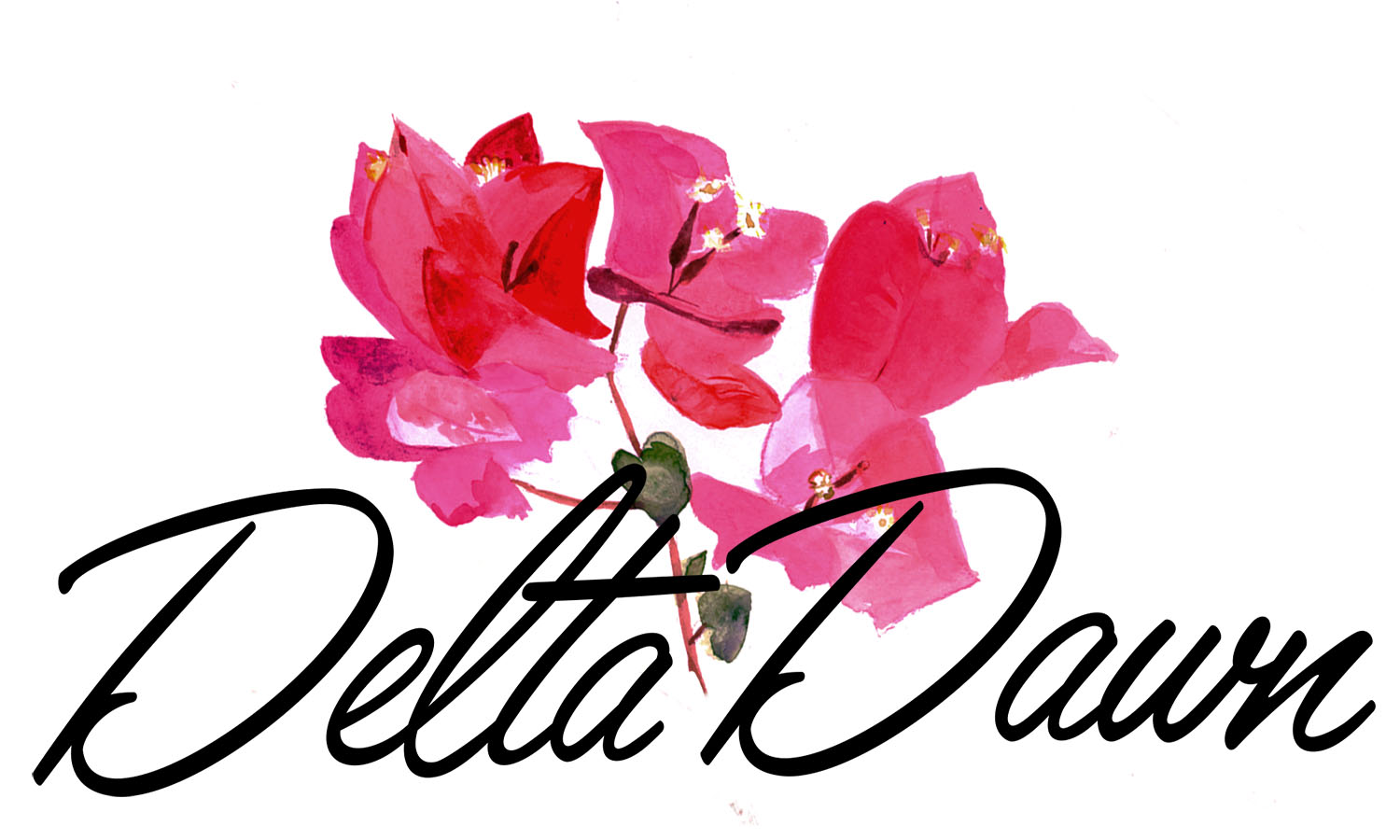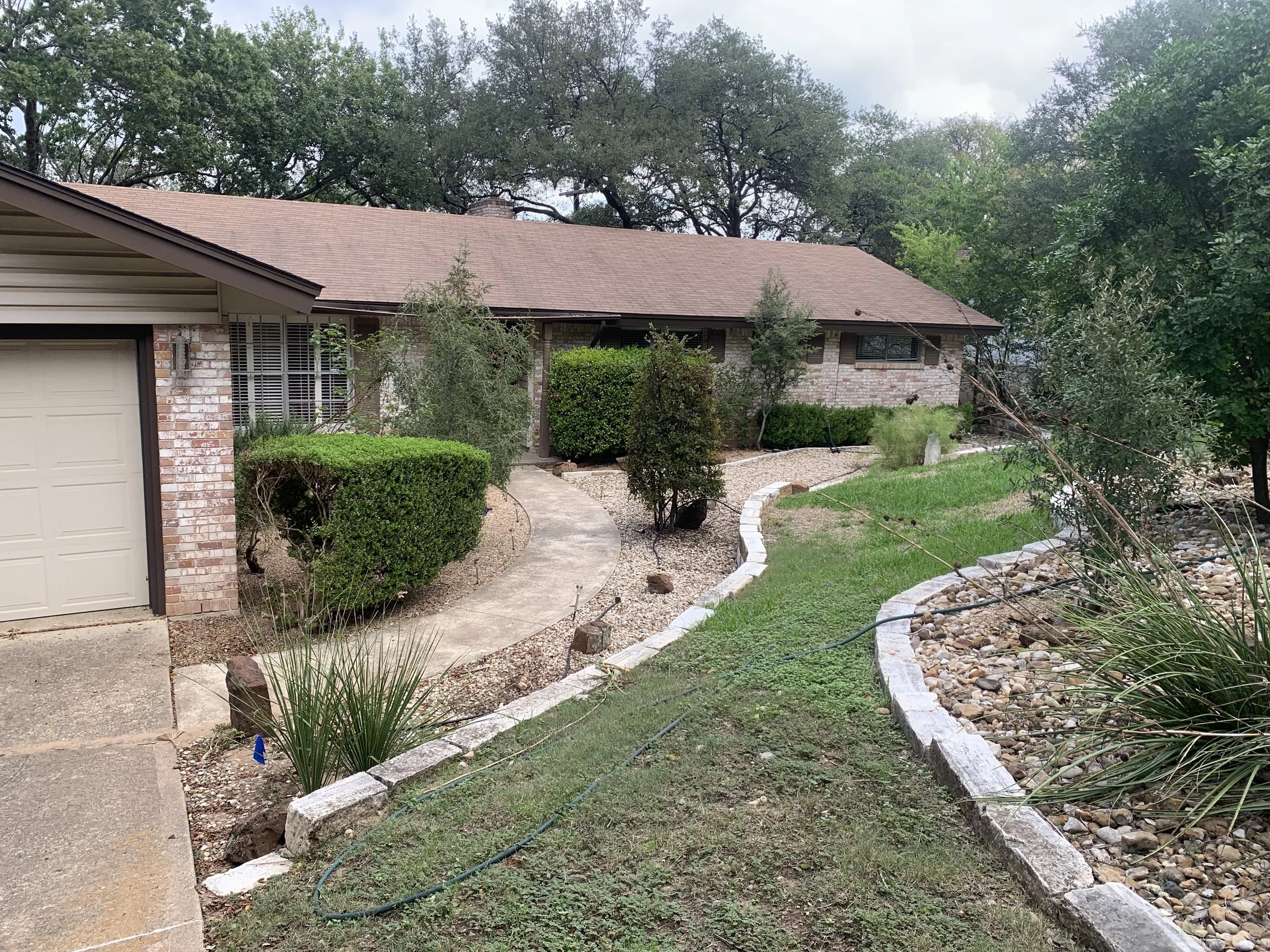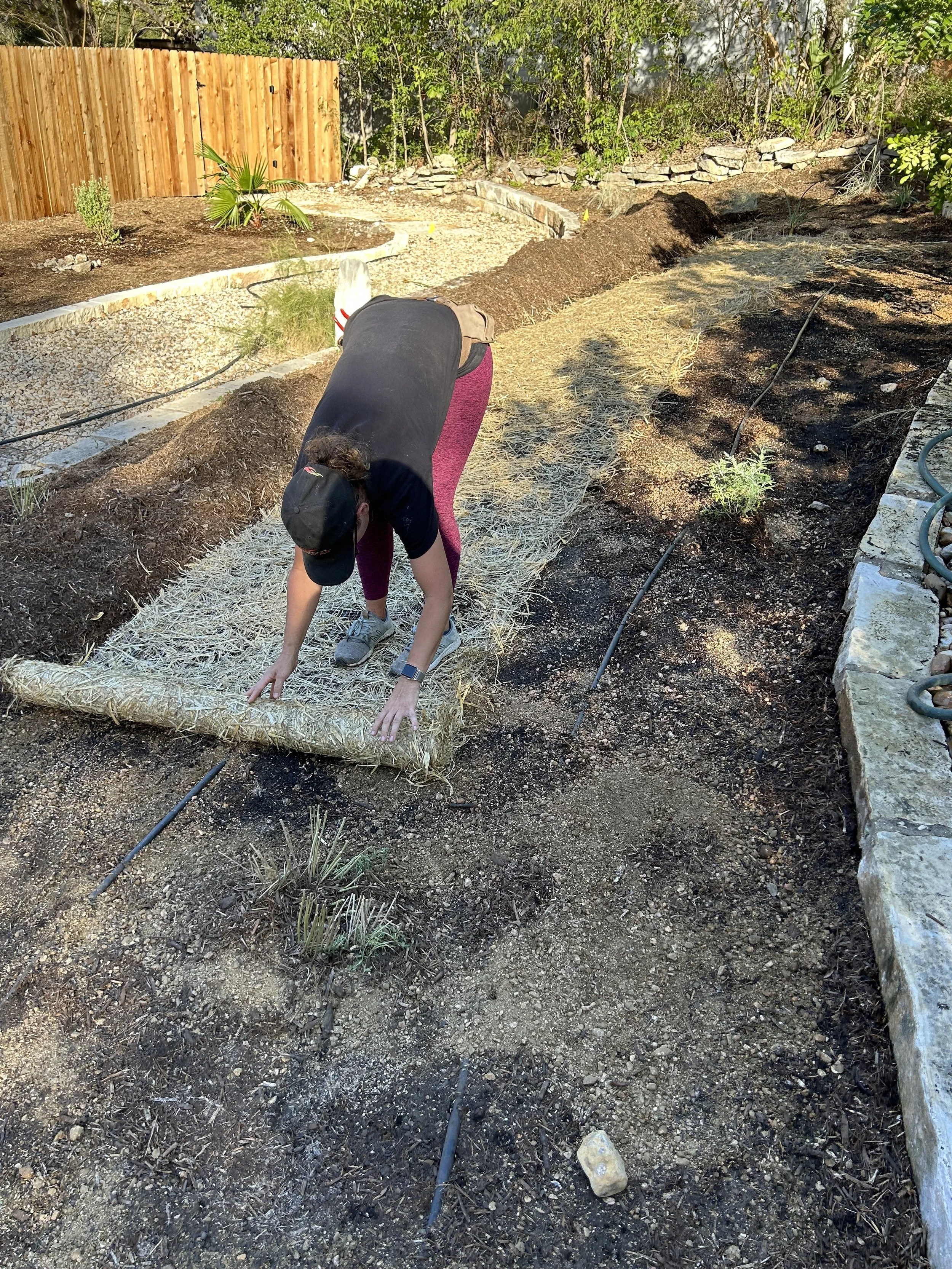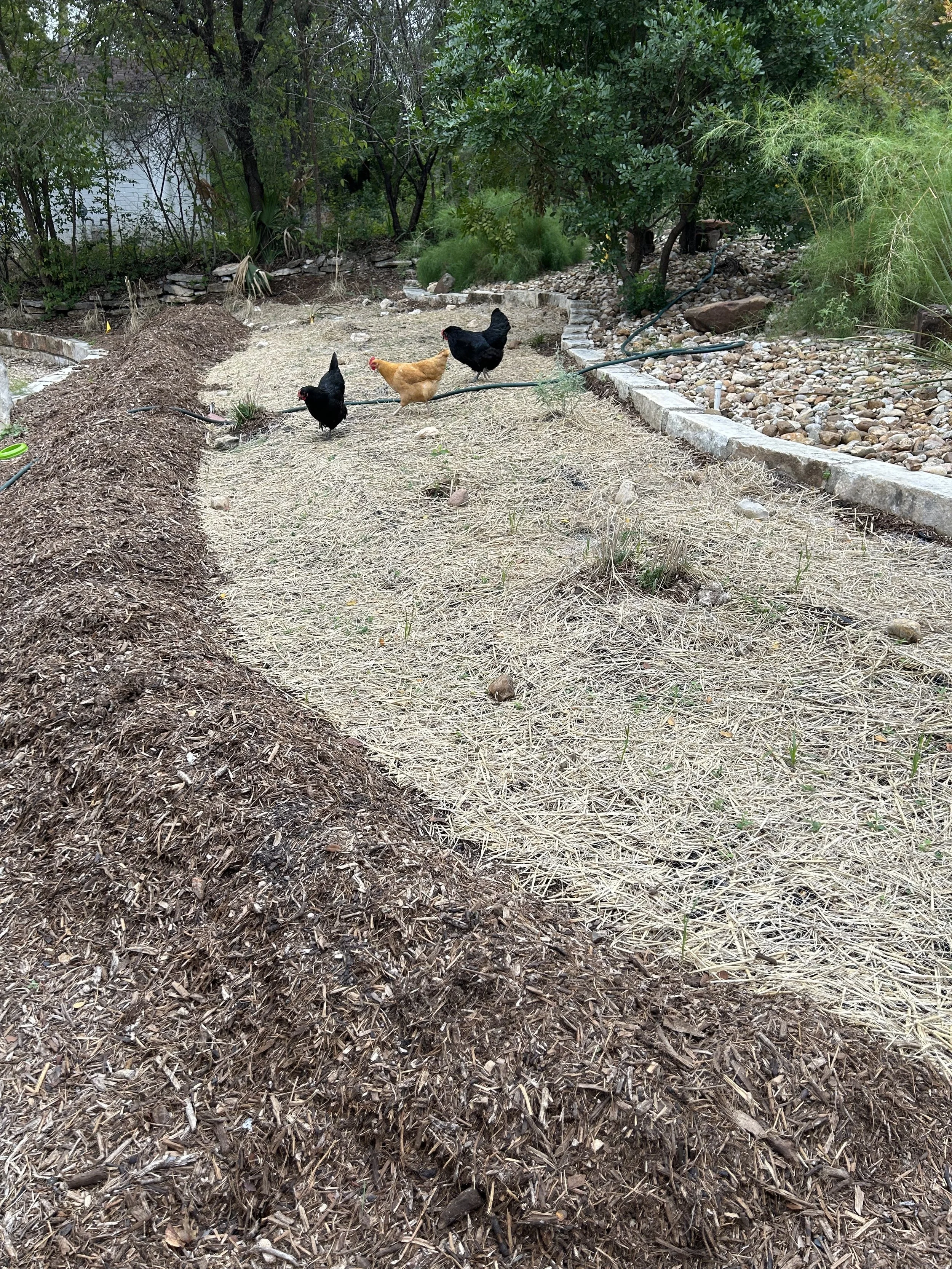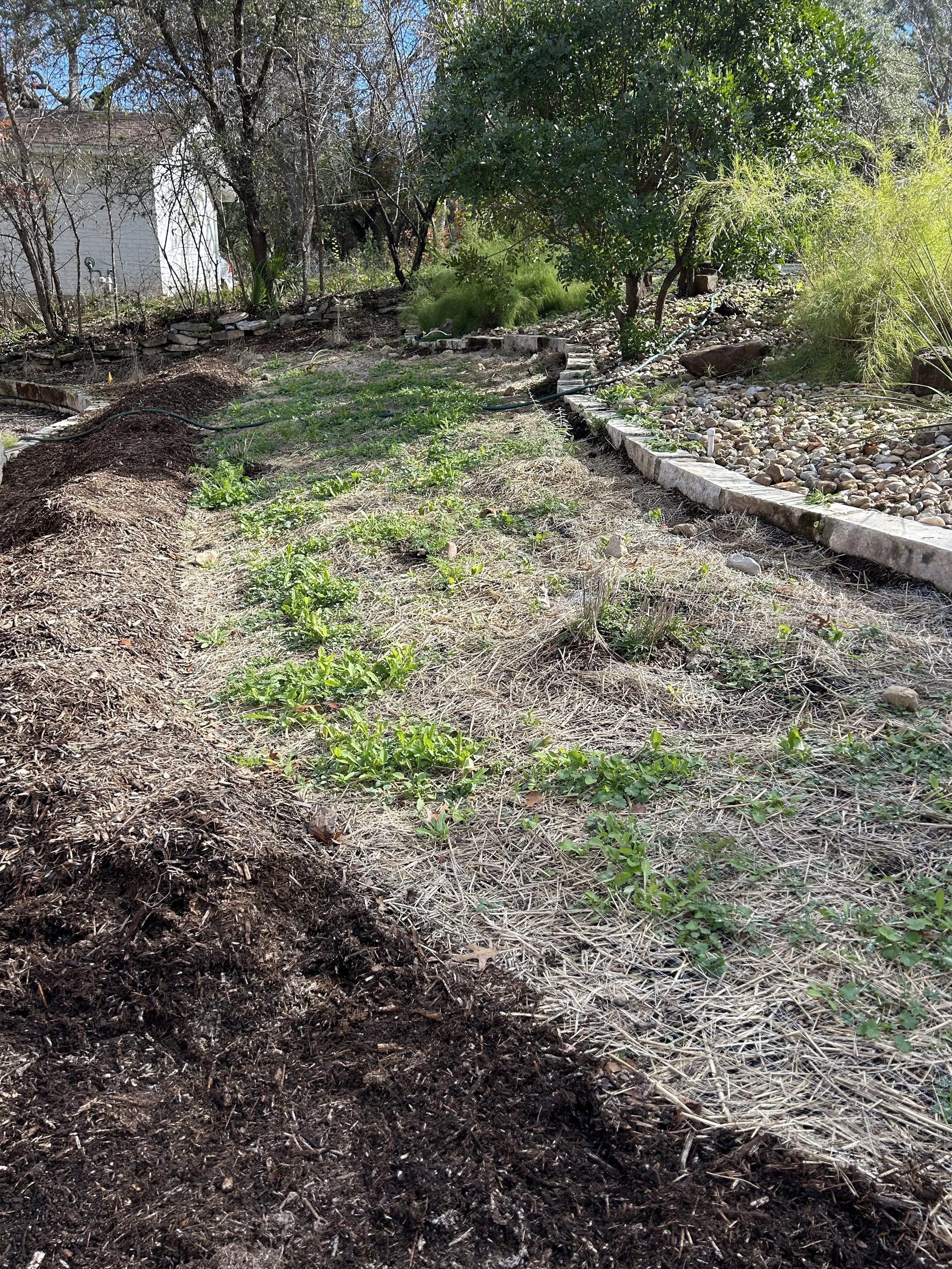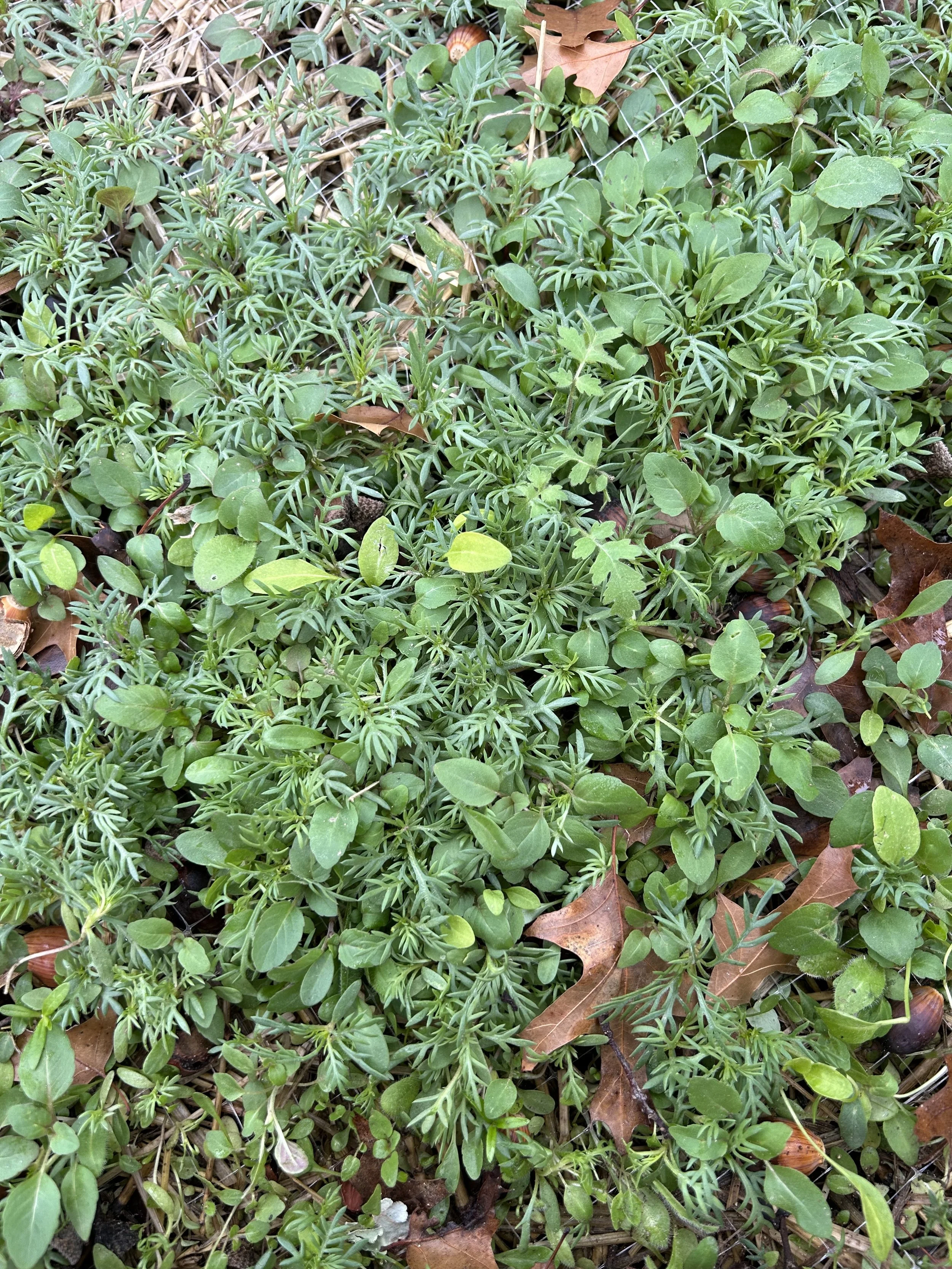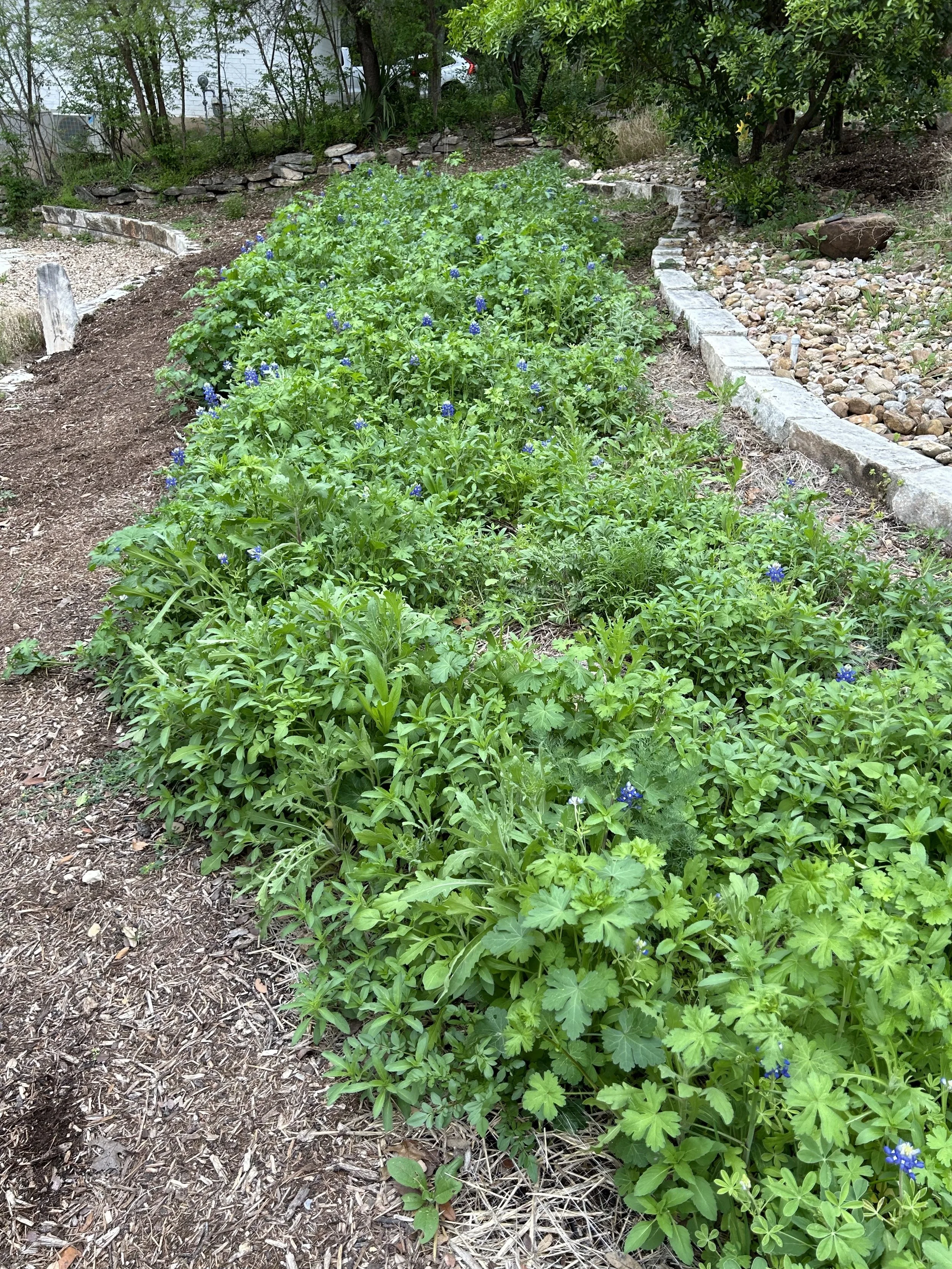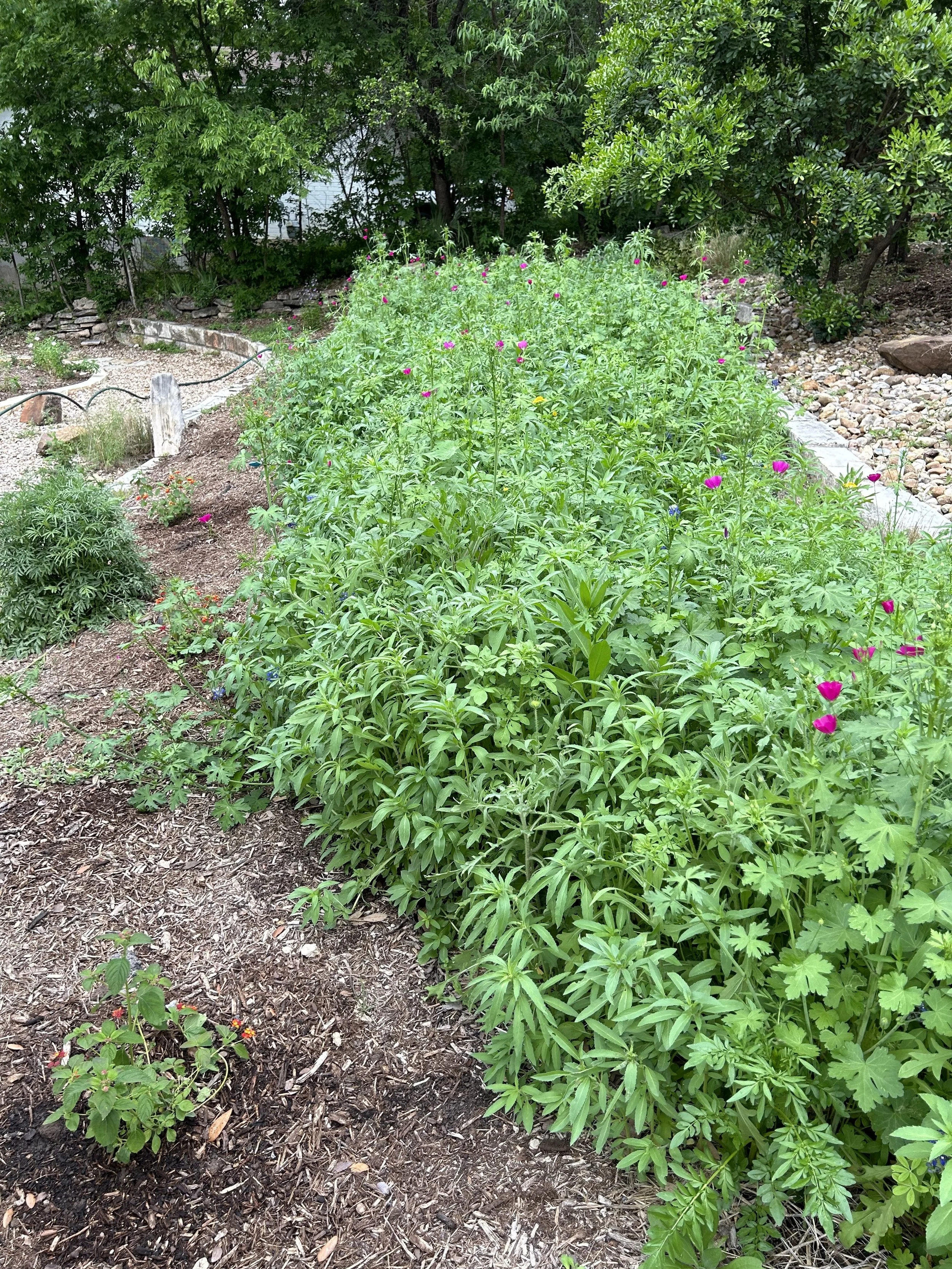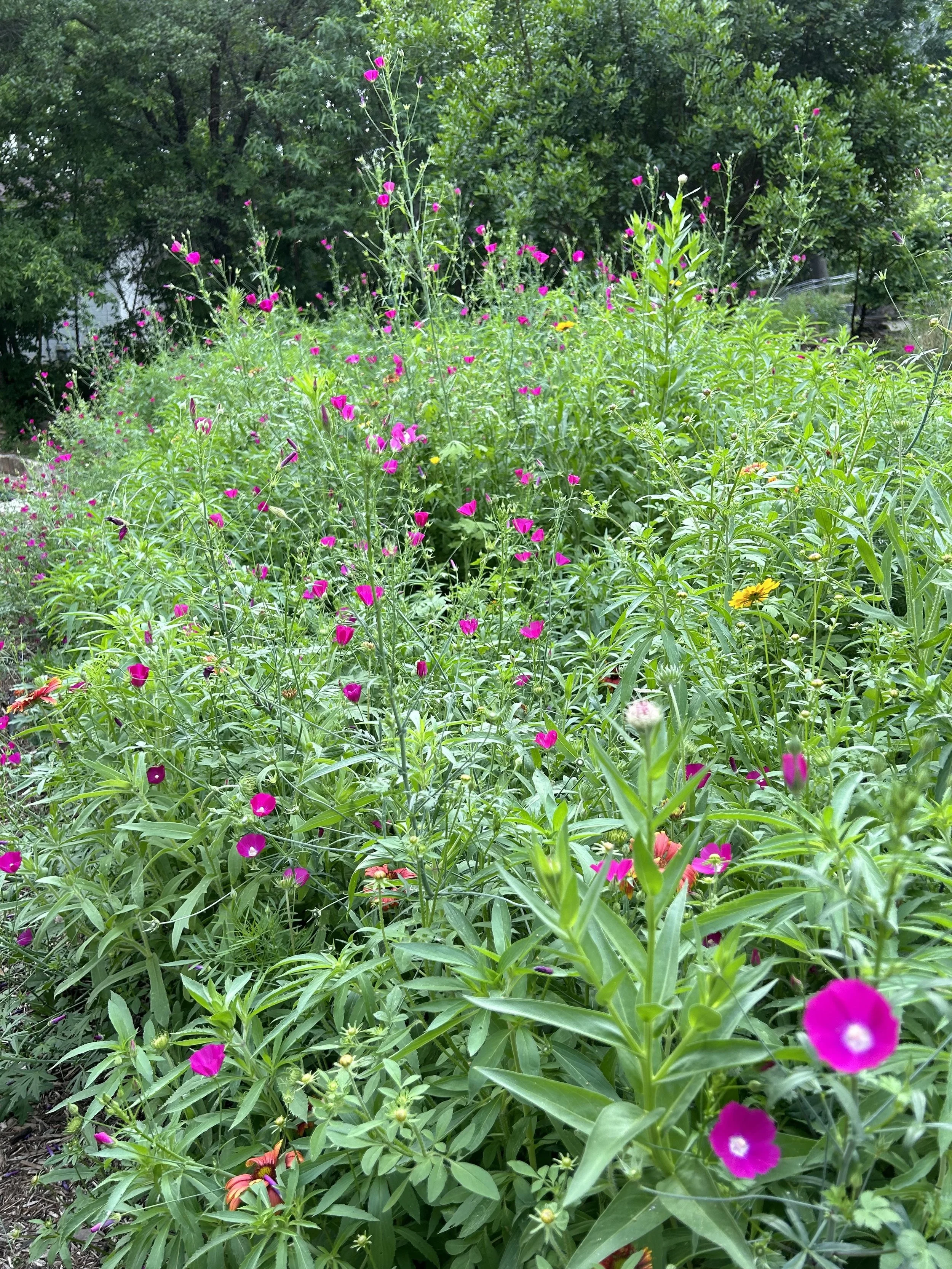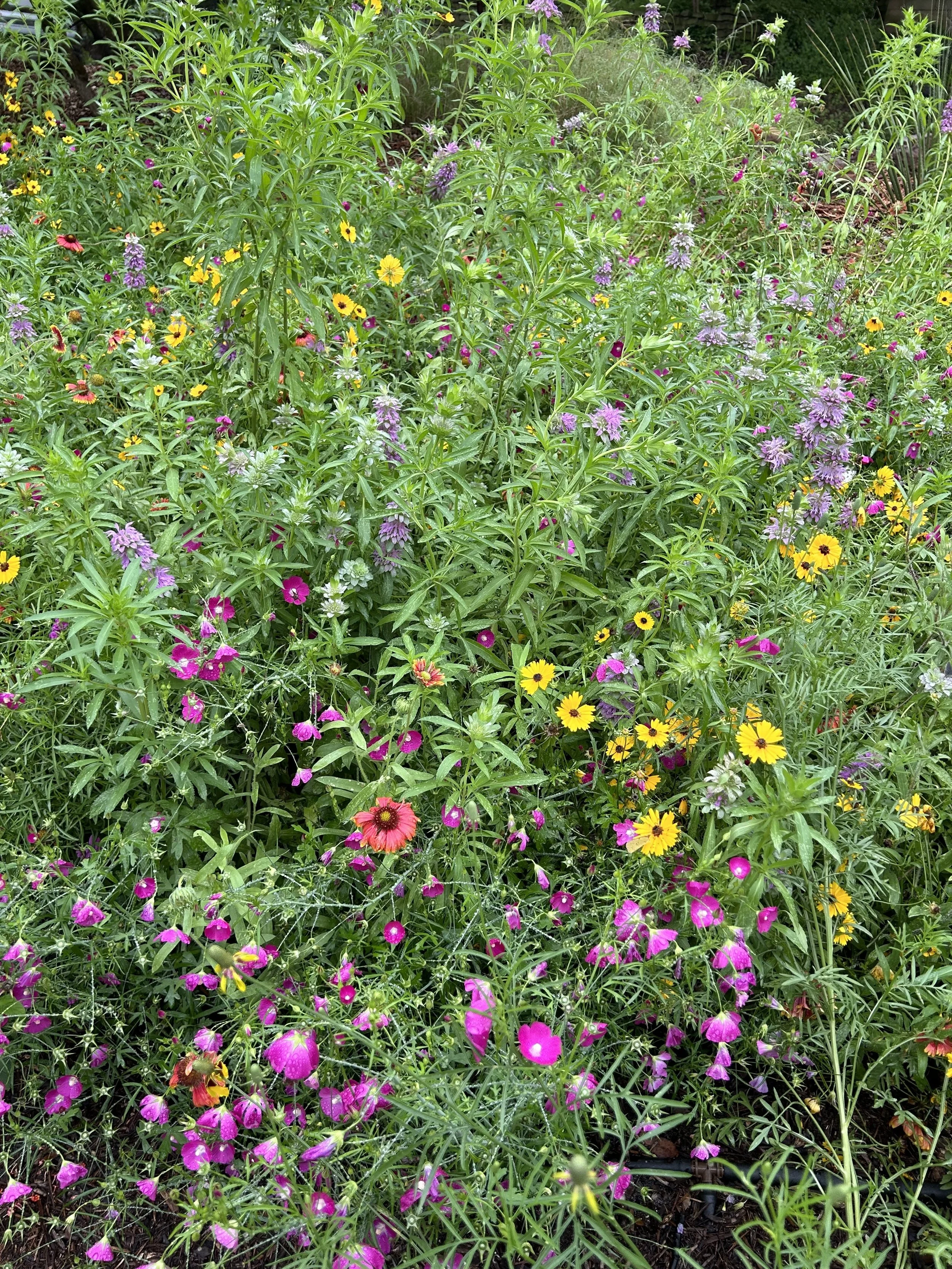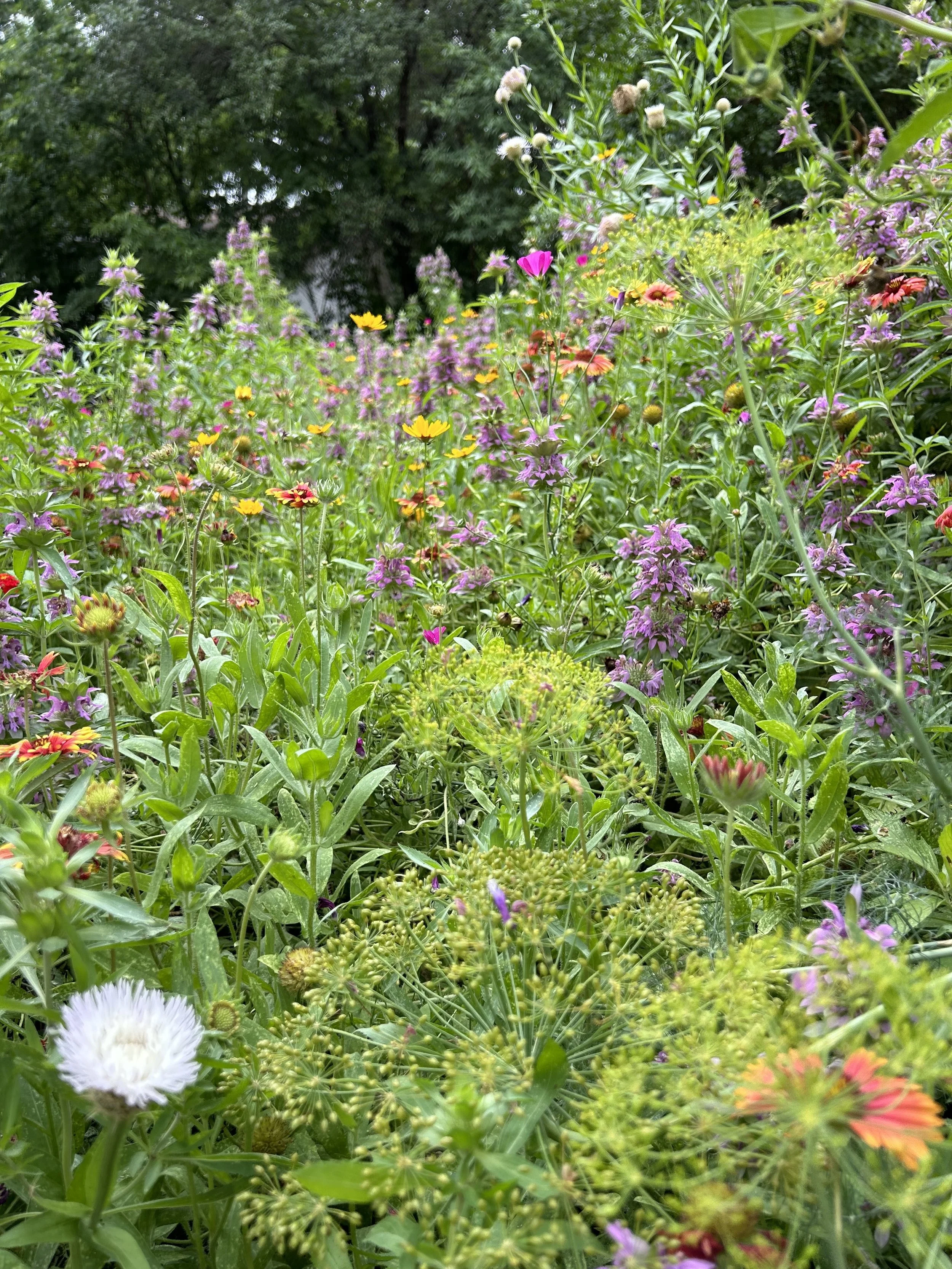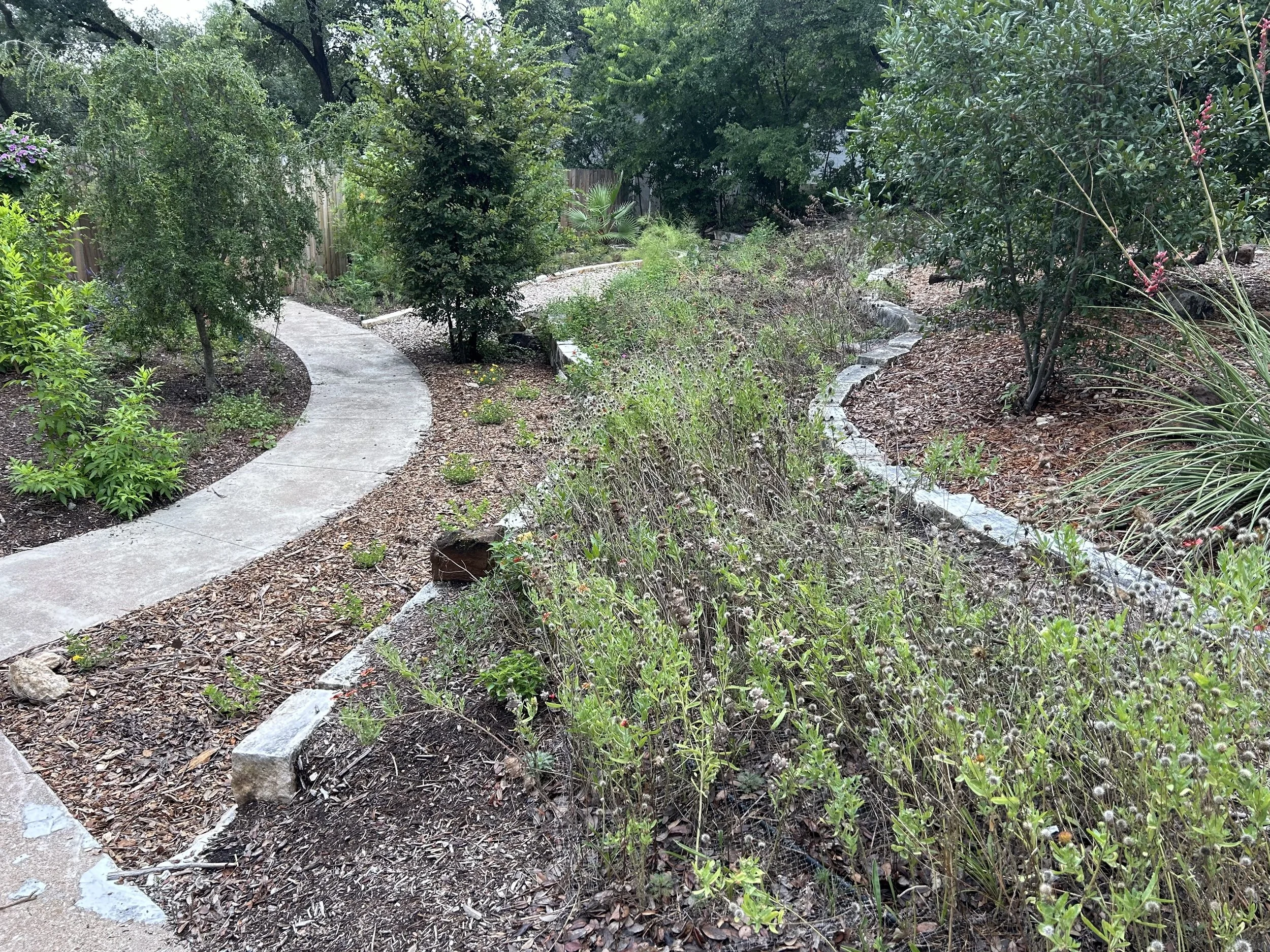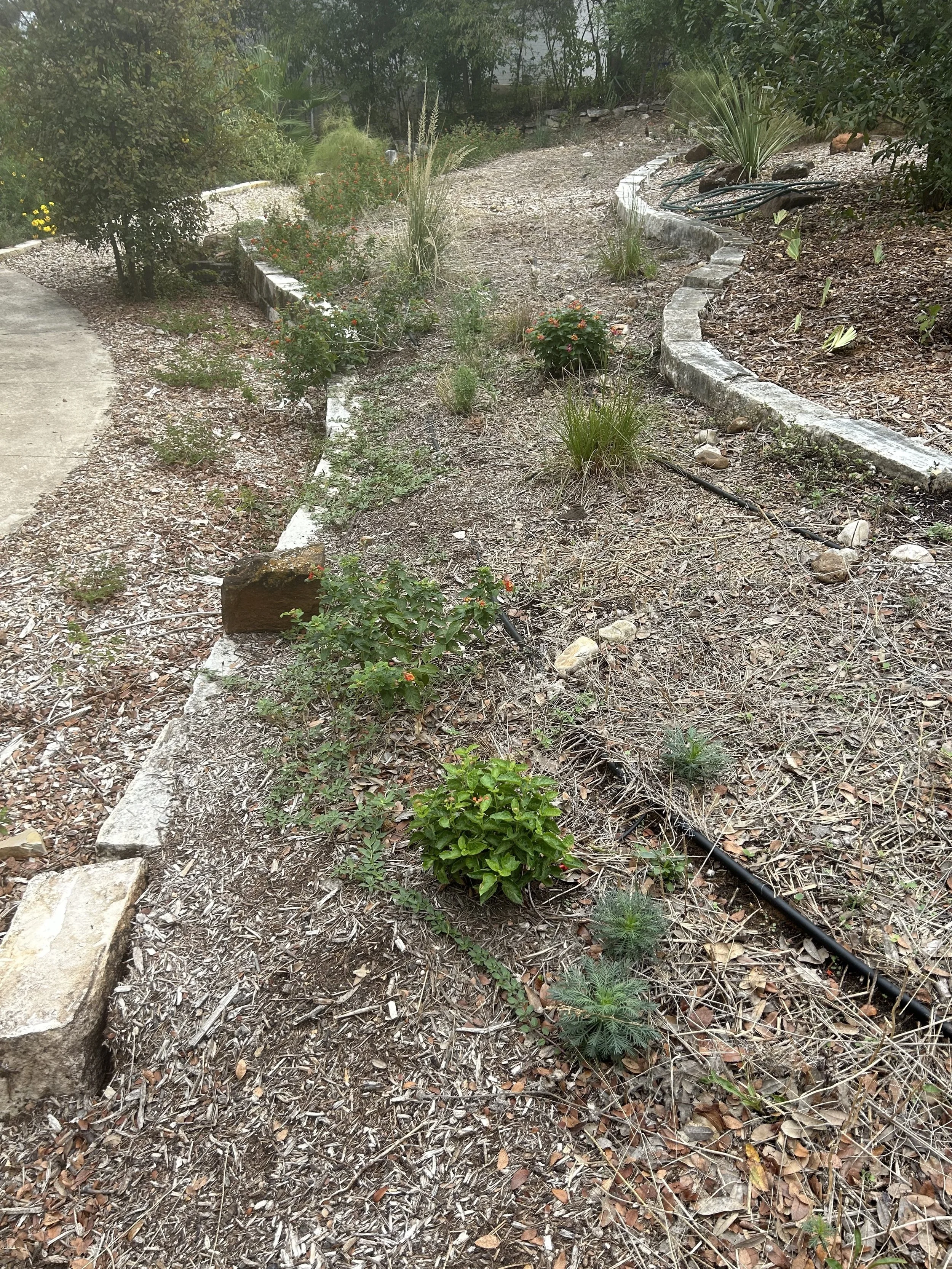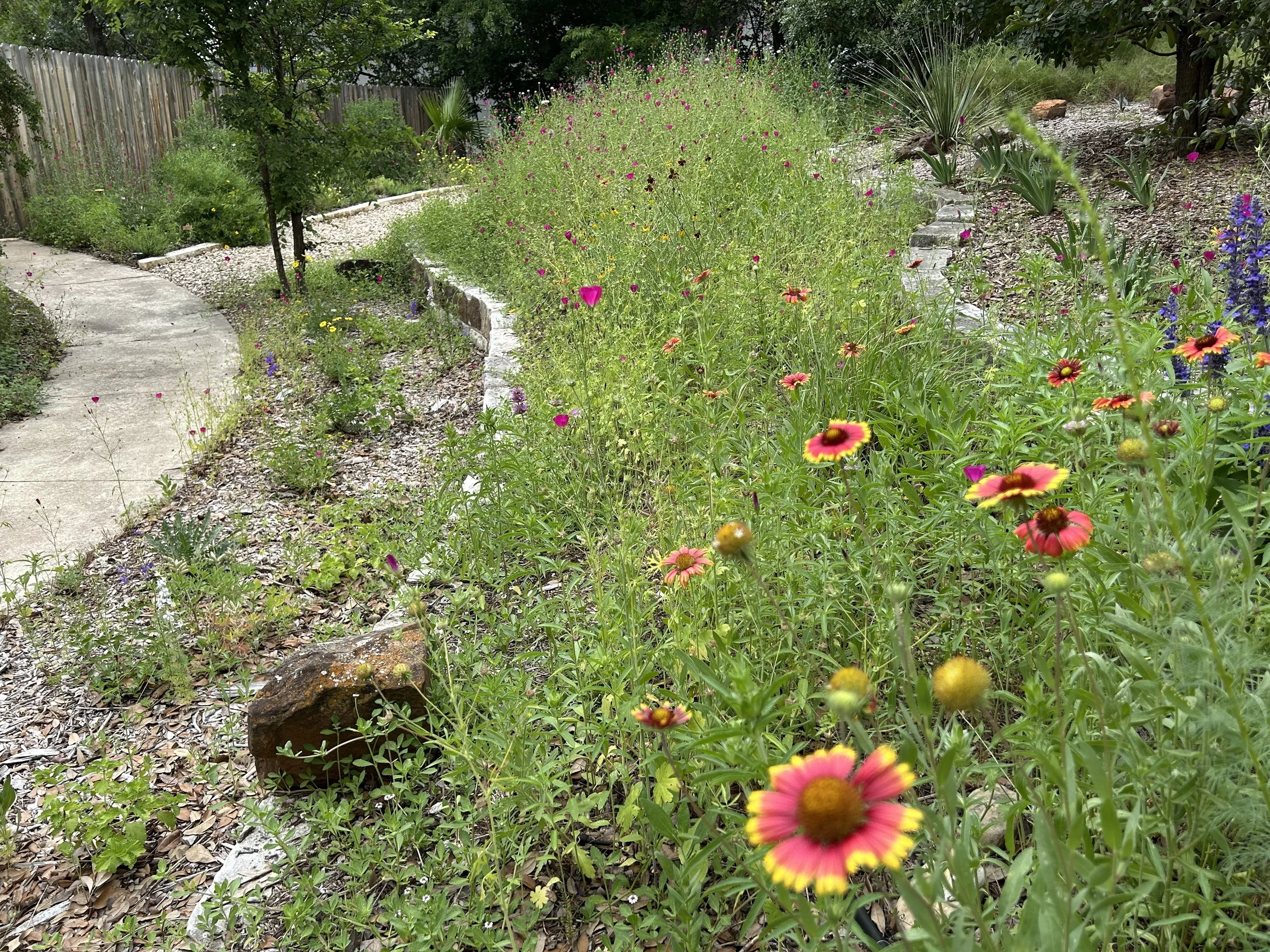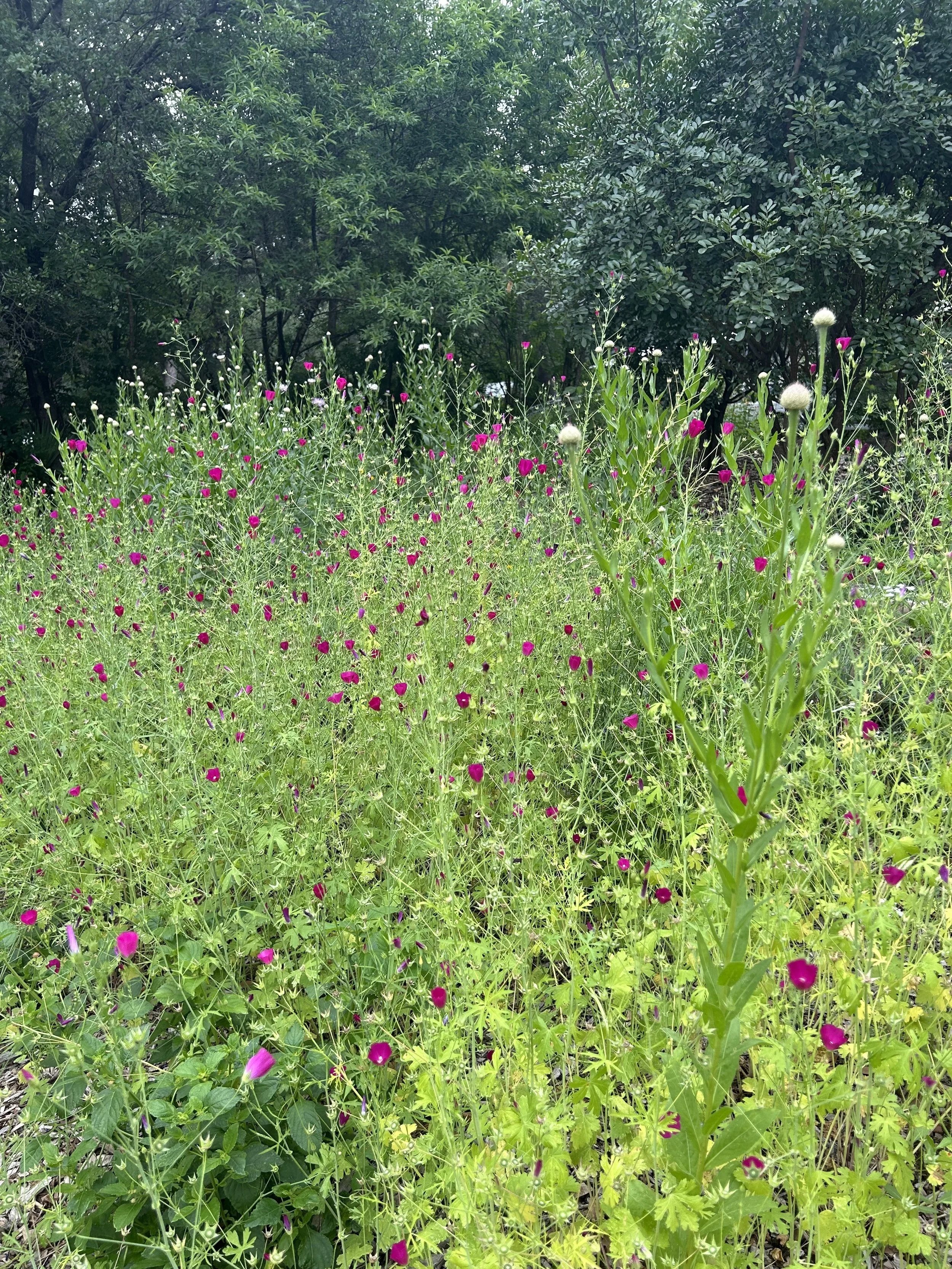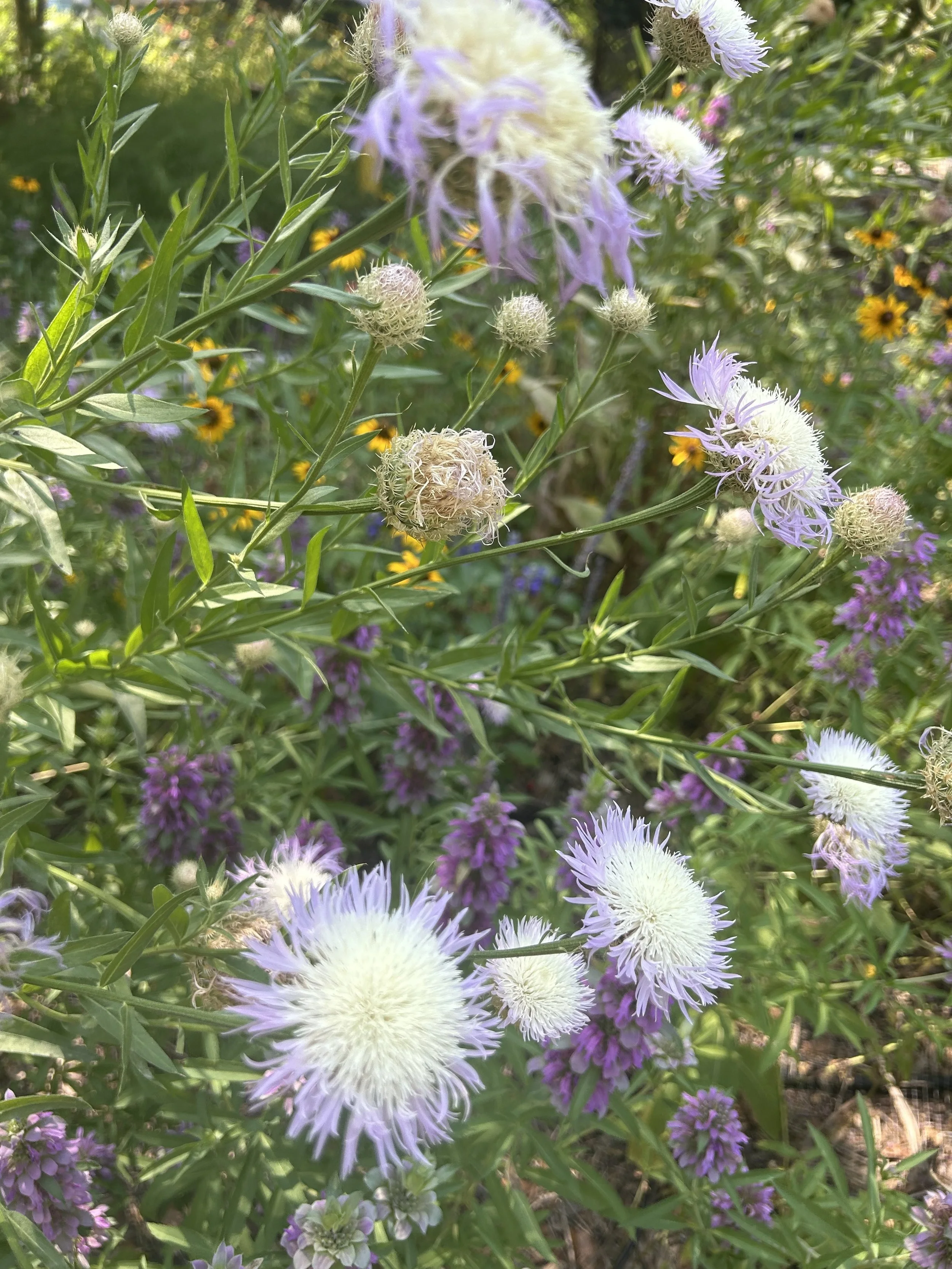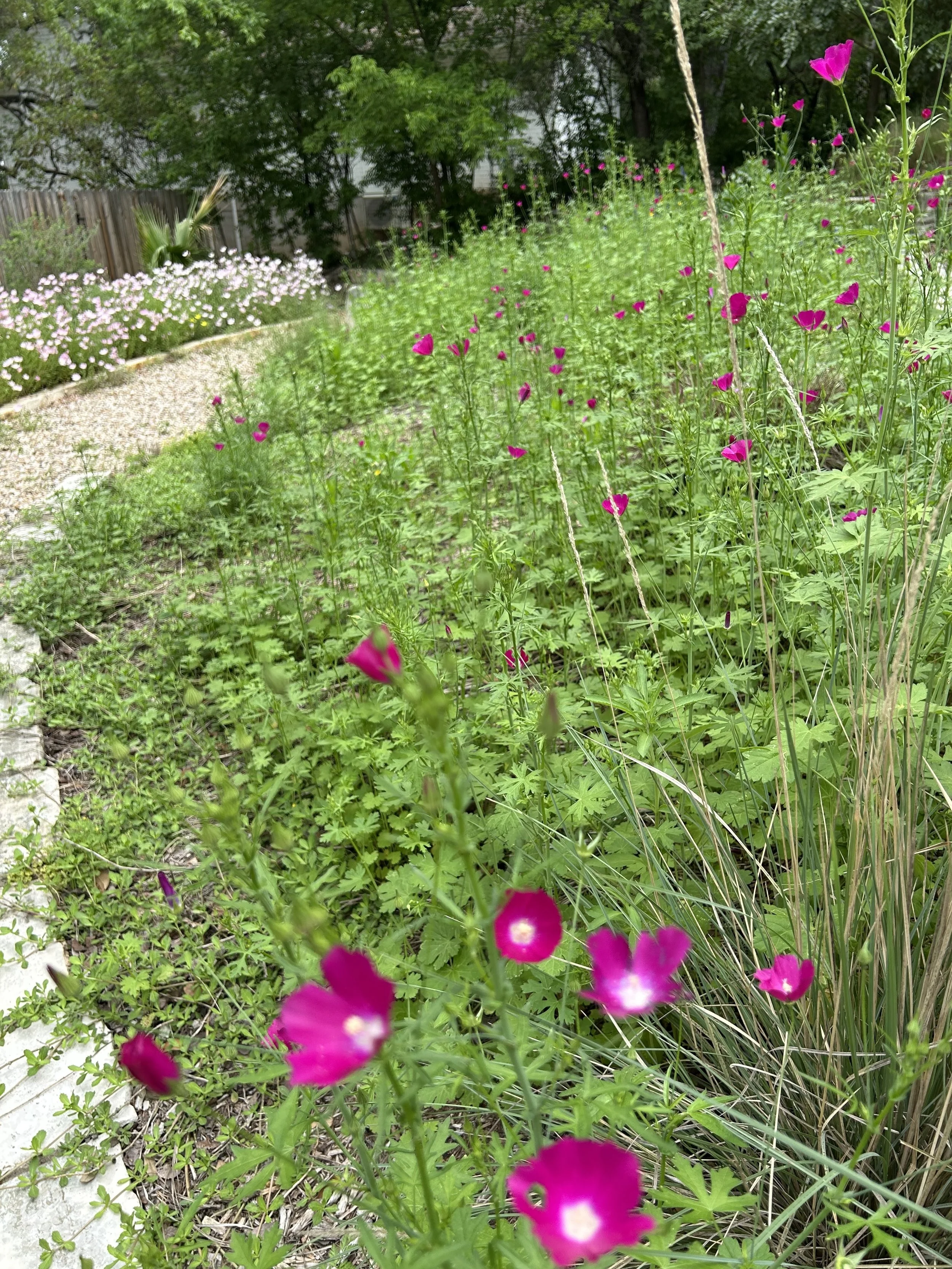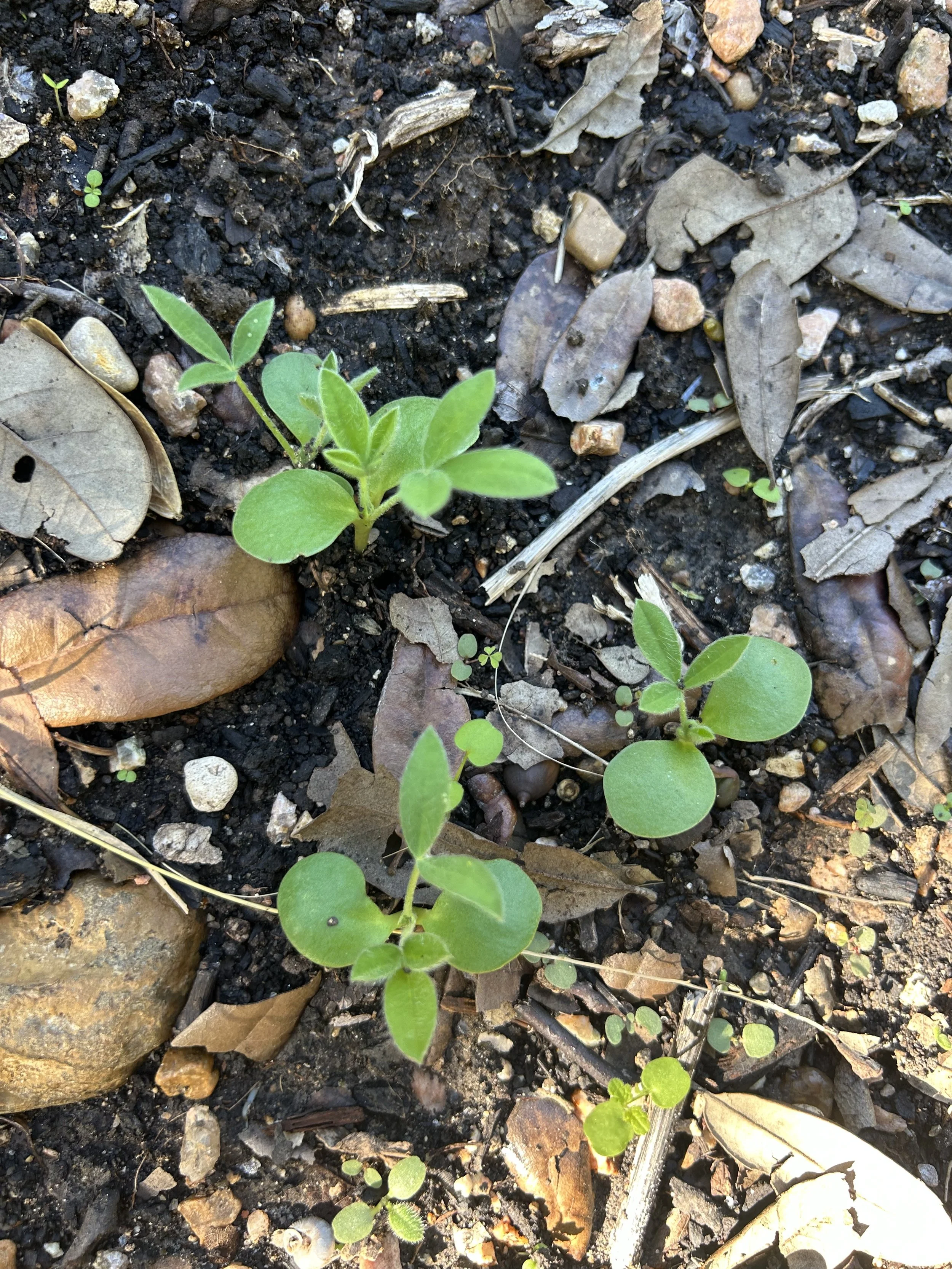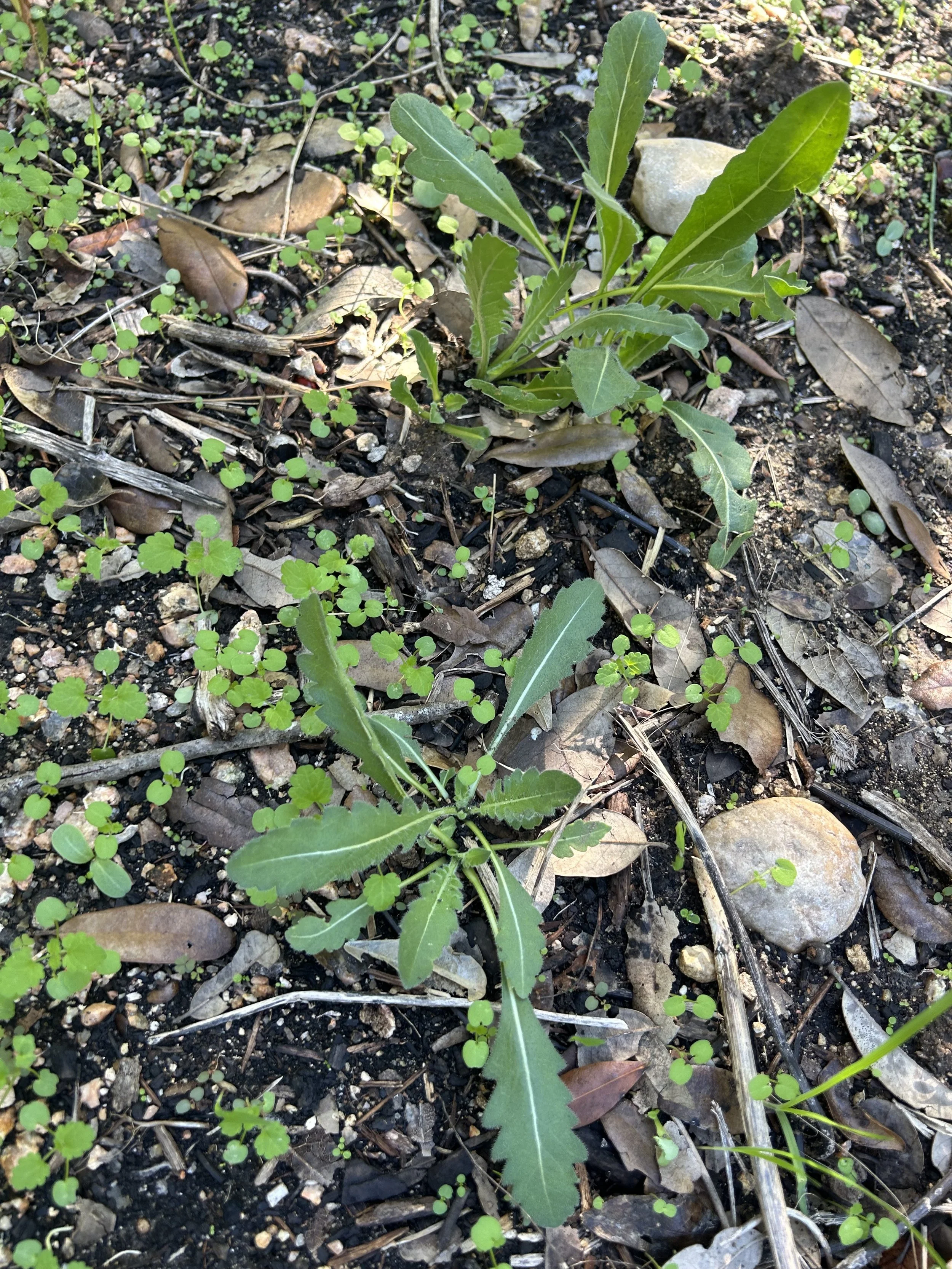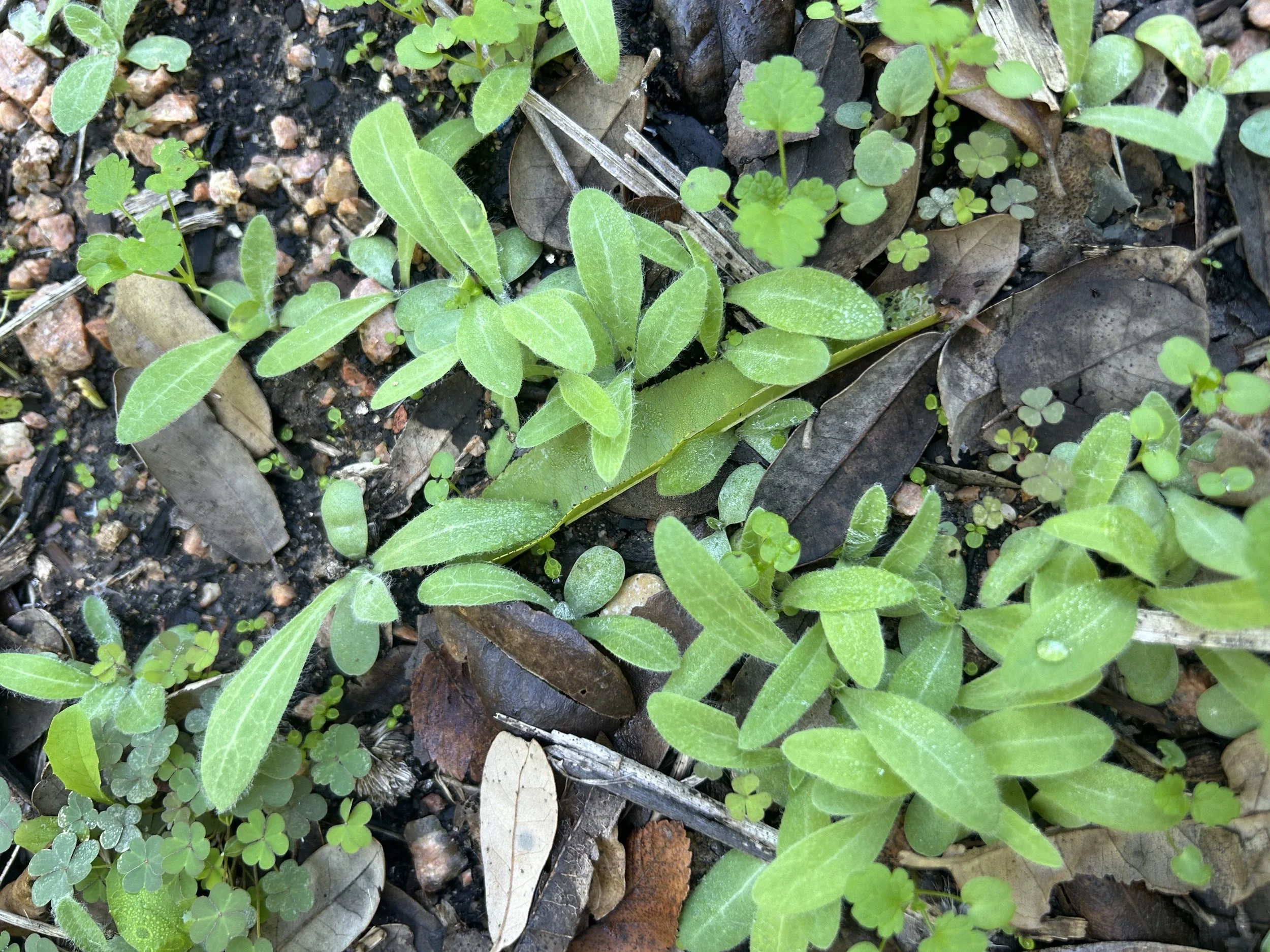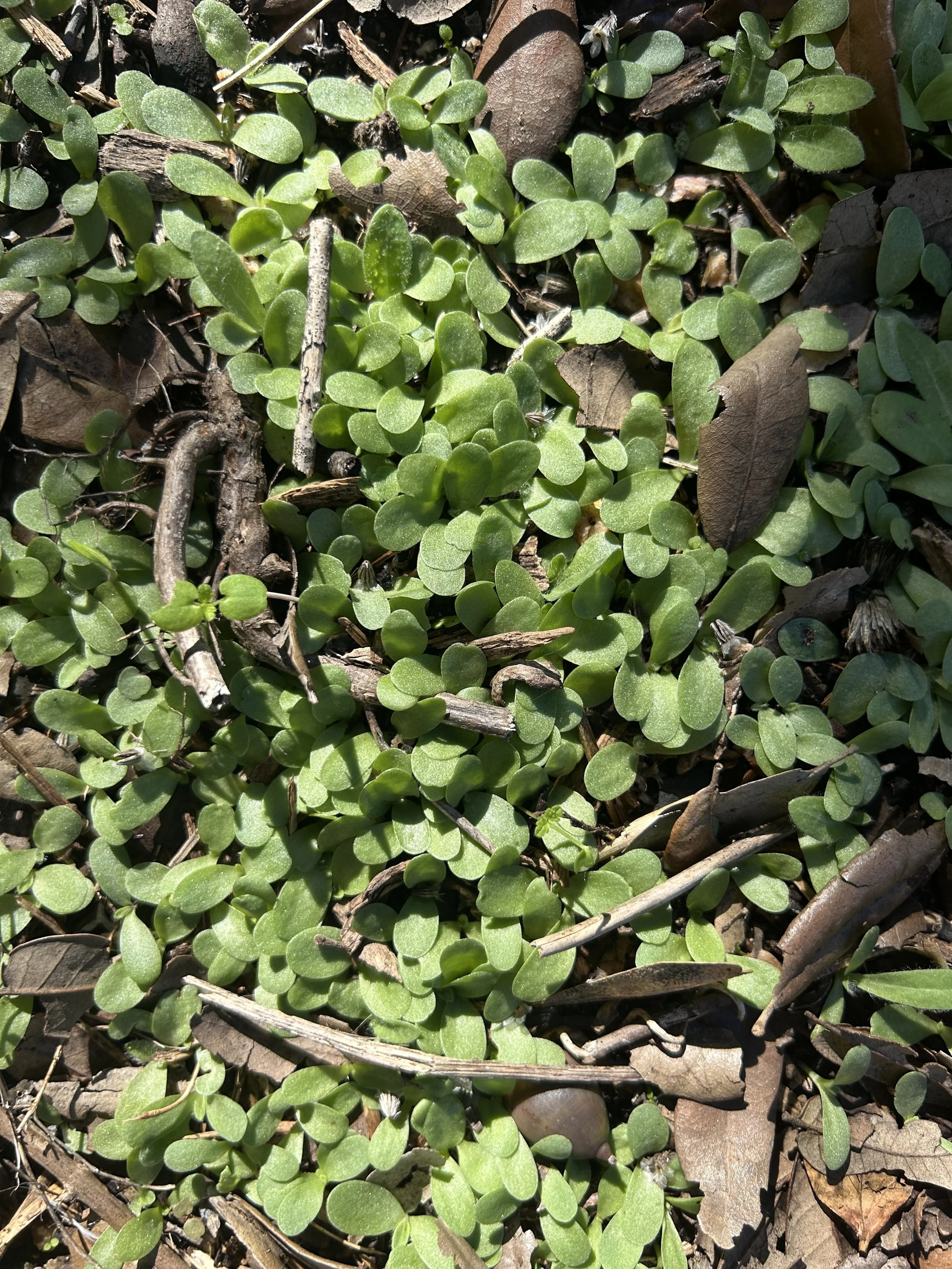Pocket Prairie
One of our ongoing projects is converting this former turf grass lawn area into a pocket prairie. A pocket prairie is a small-scale, designed version of a natural prairie intended to support biodiversity and promote ecosystem services such as carbon sequestration, erosion control, soil remediation, and pollination. Dominated by wildflowers in the winter and spring, and grasses and perennials in the summer and fall, a pocket prairie provides native habitat for insects, birds, and other wildlife.
Learn all about pocket prairies on this 2022 episode of Leah’s podcast, The Horticulturati, featuring an interview with local expert John Hart Asher.
Pocket prairies take several years to establish. Below, read about the steps we’ve taken and lessons learned along the way.
May 2025 (2nd spring after planting)
2022: Before
Before the house was demolished, this area was a fading lawn with some St. Augustine grass and some weedy areas. Because of its relatively small size, full sun exposure, and because we wanted to experiment with lawn conversion, we selected this area for our pocket prairie.
Spring-Summer 2023: Bed preparation
After the demolition of the house, we contracted with Seedlings Gardening to install hardscape throughout the garden. Here are the steps we took for bed preparation:
Roto-tilled former lawn area
Installed solid 1/2” drip irrigation lines spaced 3’ apart
Added 2” of compost and 2” of hardwood mulch.
We did not bring in additional soil because we wanted to work with the native rocky clay, a soil type that is poor for lawns, but great for native plants.
Fall 2023: Sowing seed mixes
Here is how we planted the pocket prairie:
Removed all mulch from the planting area and added a 1/4” dusting of decomposed granite. Wildflower seeds seem to germinate better in DG.
Installed a straw erosion-control blanket to prevent the seeds from washing down the slope. Here, we made the mistake of buying a straw roll product from Home Depot, which included what was advertised as a “photodegradable” netting but was actually just plastic. Two years in the Texas sun has done nothing to degrade the plastic, and we’re still pulling it out. A better alternative would have been Native American Seed’s Wood Fiber Erosion Control Blanket, which is fully biodegradable and doesn’t include plastic.
From Native American Seed, sowed 1 lb of Lady Bird’s Legacy Mix and 2 DPACs of Pocket Prairie Mix, and several 15 sq.ft. packets of annual winecups.
We installed a few little bluestem and muhly transplants.
Hand-watered the area deeply — twice a week for the first month, then once a week after that (unless it rained).
Holly rolling out the ill-fated straw blanket from Home Depot.
A neighbor’s chickens came to visit after planting.
January-February 2024: Weeding the seedlings
Learning to identify wildflower seedlings takes practice. If you’re new to it, keep it simple: learn to identify winter weeds and don’t pull anything else until it gets big enough to identify. The #1 invader to watch out for is wild carrot (Torilis arvensis, a.k.a. hedge parsley or beggar’s lice). Pulling wild carrot alone will keep you busy. Another common non-native is henbit (Lamium amplexicaule), which may or may not be a weed, depending on your opinion. We let it fill in gaps because it blooms early for the bees.
March 2024: First blooms appear
Spring 2024: Wildflower explosion!
Average rainfall over the winter set the stage for excellent diversity of wildflowers.
Monarda, Gaillardia. American basketflower, Coreposis, winecups, and dill. Dill is non-native but it’s a host plant for black swallowtail butterflies.
Summer 2024: Gone to seed
After the big spring show, it’s tempting the cut down the faded wildflowers. However, it’s important to let these annual plants remain in the ground through mid-summer so that their seeds will have time to mature, dry, and disperse. If you remove seeds when they’re still green, they won’t be viable. This is when the pocket prairie looks its worst. At least birds enjoy snacking on the seeds.
Fall 2024: Where are the grasses?
While we had early success growing wildflowers from seed, the grasses were a different story. None of the grasses in our pocket prairie mix germinated the first year. By late fall, we didn’t have much of a prairie at all! We learned a few things. First, that our planting ratio was off — too many wildflowers, not enough grasses — and second, it’s hard to establish warm-season prairie grasses from a seed mix alone. We decided to buy nursery-grown transplants the following spring.
Spring 2025: Wildflower reprise
Probably due to factors of drought and natural succession, the wildflower display was different in the second year, with annual winecup (Callirhoe involucrata) and American basketflower (Centaurea americana) dominating the prairie. We added transplants of Indiangrass and sideoats grama, along with perennials including salvias, mistflowers, and lantanas.
Callirhoe involucrata
Centaurea americana
Pink evening primrose blooms in the background.
Fall 2025
Getting better, but there’s still much room for warm season grasses! A few species germinated in the second year, including little bluestem, purple lovegrass, and sideoats grama. Frogfruit is spreading out to cover bare soil. Unfortunately, the fall drought is bad. Wildlfower seeds are sprouting due to a heavy dose of city water. Winecups are ascendant again, with a supporting cast of basketflower, Engelmann daisy, and black-eyed susan. We added bluebonnet transplants and more sedges. The rings of rocks around the plants deter armadillos.
Looking slightly less brown than fall of 2024, despite the September-October drought.
Annual winecup seedlings cover the ground.
Left: ‘white cloud’ muhly. Right: Lindheimer (big) muhly.
Left: Indiangrasses are starting to fill in.
Bluebonnet
Engelmann daisy
Huisache daisy (Amblyolepis setigera)?
American basketflower (?)
Interested in pocket prairie design? Visit the Contact Page to get in touch!
